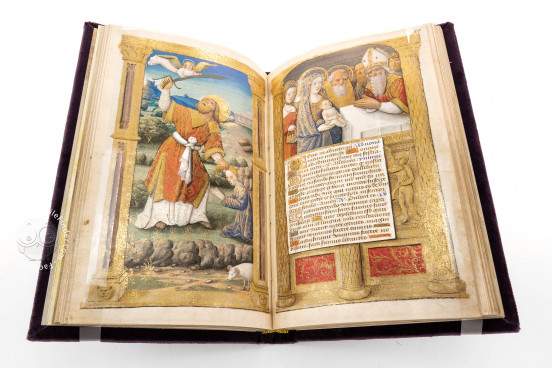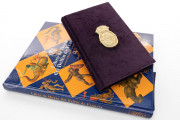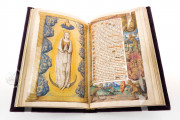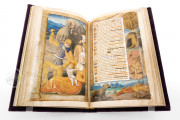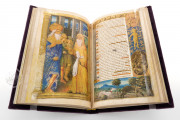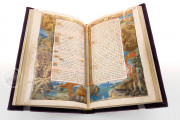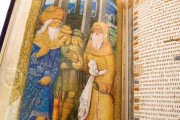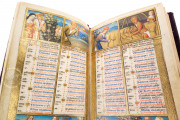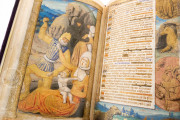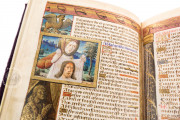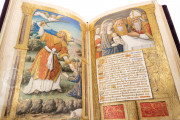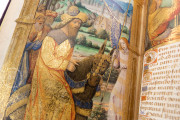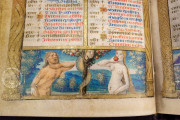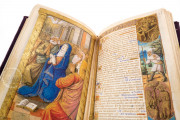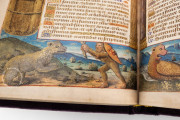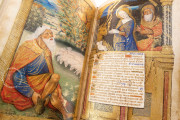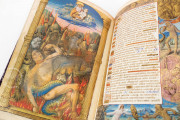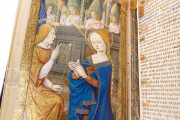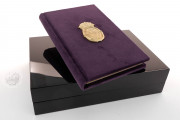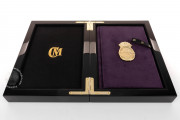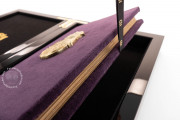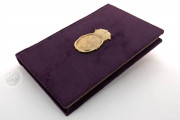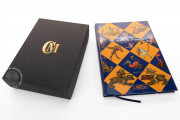The so-called Hours of the Dauphin of France in Grenoble is a lavishly illuminated Christian prayer book created in Bourges in the 1490s. Every page has painted embellishment in the form of a historiated, inhabited, or decorated border, and there are fourteen full-page miniatures. The illumination includes unusual biblical subjects, inventive fictive architecture, amusing hunting and other genre scenes, and vignettes of individual figures and narrative scenes as fictive relief sculptures. The manuscript's illumination is attributed to the Master of the Monypenny Breviary.
The manuscript is a book of hours. At its core is the Hours of the Virgin—a daily round of prayer services focused on the Virgin Mary. It also includes the prayer services of the Hours of the Cross and the Hours of the Holy Spirit, the Penitential Psalms, and prayers addressed to saints.
Monumentality and Camaïeu
The manuscript's miniatures are in the characteristic style of illumination practiced in Bourges in the last quarter of the fifteenth century. The figures are convincingly three-dimensional, monumental, and often shown in close-up view; interior architectural settings are grand; and deep landscape settings are atmospheric.
An arresting aspect of the manuscript's painted borders is the representation of figures and narrative vignettes in camaïeu as fictive oval medallions in low relief. The medallions are rendered in tones of brown with shimmering gold highlights. Several feature a young man—perhaps the manuscript's patron—shown in prayer, either alone or with others (e.g., on fol. 52v). In the prayer services for the Virgin, many depict the Old Testament king David, either in prayer or in narrative scenes, such as playing the harp before King Saul (fol. 37v). Scenes from the life of Job in camaïeu fill the borders of the Office of the Dead.
Unusual Calendar Decoration
As is common in books of the hours, the manuscript opens with a liturgical calendar (fols. 1v-4r). The calendar of the Grenoble manuscript, arranged two months to a page, includes twelve small miniatures at the tops of pages depicting the months' labors with the appropriate zodiacal sign often integrated into the laboring scene. The compositions of these calendar miniatures owe a debt to the corresponding scenes in the Hours of Louis de Laval. The lower margins are occupied by scenes of the fall of humanity from the Creation of Adam to the Expulsion from the Garden of Eden.
Rare Old Testament Scenes
The pictorial treatment of the Hours of the Virgin combines elements of the conventional cycle of scenes from the infancy of Christ and the Assumption of the Virgin with the Old Testament episodes of the Lord appearing to Moses in a burning bush (fol. 19v), Abraham traveling to Moriah (fol. 21v), and the Sacrifice of Isaac (fol. 25v). Most remarkable is the inclusion of a full-page miniature of a fleet of ships paired with the Adoration of the Magi (fols. 23v-24r) at the opening of the daytime prayer service of Sext.
Exploits of Wild Men
The borders are populated by captivating scenes of the adventures of wild men—usually hairy from head to toe and brandishing weapons—who encounter dragons, hybrid beasts, an elephant, a camel, and a crocodile. There are also many hunting scenes involving a variety of prey.
Dazzling Initials and Line-Fillers
A single scribe writing in French Bâtarde penned the manuscript's text. There are hundreds of painted initials of gold on colored grounds and line-fillers with scrolling gold filigree: in the poetic texts of the psalms, the line-fillers dominate the page. The rubrics—labels customarily in red ink—are in blue.
A Misleading Nickname
We do not know who commissioned the manuscript. It owes its designation "of the Dauphin of France" to the circumstance that the book is preserved in Grenoble, the capital of the southeastern French region of the Dauphiné, which—thanks to a territorial transaction of the fourteenth century—lent the name Dauphin ("dolphin," after the emblem of the count of Vienne) to the heir apparent to the French monarchy for centuries.
We have 1 facsimile edition of the manuscript "Hours of the Dauphin of France": Libro de Horas del Delfín de Francia facsimile edition, published by CM Editores, 2018
Request Info / Price
